ISSN ONLINE(2319-8753)PRINT(2347-6710)
ISSN ONLINE(2319-8753)PRINT(2347-6710)
Dr. Rukhsana1 and Asraful Alam2
|
| Related article at Pubmed, Scholar Google |
Visit for more related articles at International Journal of Innovative Research in Science, Engineering and Technology
After independent there have been Indian State took a variety of Constitutional and administrative measure for socio-economic development of schedule population in the county. Nevertheless there are wide variations in socioeconomic well being of Schedule and non-schedule Caste population in the country. Since independence there have been several reservations among the societal classes of India in different government and non-government sector. The aim of these reservations is to pull out the backward section of society and parallel them with mainstream of the society. Schedule Caste population, which make about one-sixth in country’s population, have quite low level of literacy for Schedule Caste (SC) population. In addition, there are quite inter-state, inter- district and inter-block variations. Major objective was to assess the regional pattern of literacy differential between Scheduled and non Scheduled Caste population in the State of West Bengal and to examine the rural-urban differentials in literacy rate of Schedules Castes population and how these differ from that of non-Scheduled population. The present study has been based on mainly secondary sources of data. In 2011, literacy rate of Schedule Caste in the State was 61.16 percent against 77.08 percent for the general population. Literacy level for Schedule Castes female population was much lower than the general population. For this study various GIS and cartographic techniques including maps and diagrams will be used to depict the spatial pattern of literacy attributes and their correlation.
Keywords |
| Literacy Differential, Non-Schedule Caste and Schedule-Caste (SC). |
INTRODUCTION |
| A person who is able to read and write with understanding in any language is recorded as literate. Literacy is the best possible barometer to judge the level of educational awakening in a state, leading to a minimum capacity for selflearning. Education is one of the important needs of life. A low degree of literacy is an obstacle to economic growth. Investment in education is a measure of the future development of a country. Formal schooling is a good index of a population’s educational attainment. The most of basic minimum measurement of educational status is the degree of literacy. But it is very difficult to measure the degree of literacy in accurate terms (Ghosh 1985).The literacy rates were determined by variety of social and economic factors. Often, it is not easy to prepare list of such factors determining on literacy rates. The degree of urbanization, type of economy, political background, education facilities, cost of education, degree of development of means of transportation and communication, status of woman in society, standard of living and religious groups are the factors which are influencing directly on the rate of literacy, where as physical factor like as, topography, climate and soil have indirectly influencing the rate of literacy. The Scheduled Castes (SC) are among the most socially and educationally disadvantaged groups in India. Scheduled Castes have different histories of social and economic deprivation, and the underlying causes of their educational marginalisation are also strikingly distinct. One important dimension of the notion of inclusive growth is that the benefits of growth should reach socially disadvantaged sections like the Scheduled Castes (SC) and Scheduled Tribes (ST). Even before Independence, the National Planning Committee (NPC, 1937) under the chairmanship of Jawaharlal Nehru had made detailed recommendations on a whole range of social and economic issues relating not only to agriculture and industry but also to wider issues of distribution, social justice and social welfare. Dr. Ambedkar also had a vision for socially and economically disadvantaged sections. There have been several programmes, progressive legislations and constitutional safeguards to help SC and ST (Andhra Pradesh Human Development Report, 2007). Literacy is one of the important indicators of social development. It is claimed that education is a universal right and not a privilege meant for some classes of society. The Indian Constitution and many later policy resolutions have stressed universal access to education and enrolment of children in school-going age irrespective of class and caste. Nevertheless, there is no equal access to education across social groups. In the state as well as in India, the SC is one of the most backward in terms of education. Literacy is related to religion and caste. In India proportion of literates is lower among the Muslims than that among Hindus. Similarly proportion of literates is lower among the people belongs to Scheduled Caste and Tribes. The main reason for lower proportion of literates among the Scheduled Caste and Scheduled Tribes is that they were deprived of educational facilities for generations (Sawant and Athawale, 1994). The united nation’s has defined literacy as the ability of a person to read and write with understanding a short simple statement on his every day. (Ruzicha 1972). In the census enumeration, ‘a person, who can read and write with understanding in any language, is treated as literate. The person may or may not have received any formal education’ (Census of India, 2001). The national literacy mission was launched in 1988 aiming at improving functional literacy. It has helped increasing the level of literacy and which is reflected in the entire study region. According to the 2001 Census of India, scheduled castes and tribes comprise 16.2 percent and 8.2 percent, respectively, of India’s population, yet 47.3 percent of India’s rural poor are concentrated in these groups. The incidence of poverty among scheduled caste and tribe households is much higher than for the rest of the population—in 1999/2000 the proportion of rural SC and ST households below the poverty line were 30.1 and 39.4 percent respectively, as compared with a poverty rate of 17.7 percent for rural non-scheduled households (Gang I. N. et al, 2008). |
II. STUDY AREA |
| The state of West Bengal have been selected for the study which lies between the latitude of 21°25′N to 26°50′ N and longitude of 86°30′ to 89°58′E. It spreads over an area of about 80,968 sq. Km. Extending from the foot of Derjeeling Himalayas in the north to Bay of Bengal to the south (maximum stretch of about 580 km.) and from the edge of Chotanagpur high lands in the west to the border of Bangladesh and Assam in the east (maximum stretch of about 200 km). It comprises 18 district of West Bengal. |
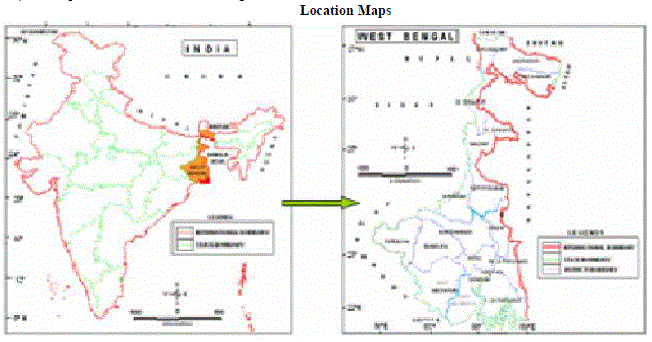 |
III. OBJECTIVES |
| The broad objective of the study is to assess the regional pattern of literacy differential between Scheduled Castes and non Scheduled Castes population in the State of West Bengal and to examine the rural-urban differentials in literacy rate of Schedules Castes population and how these differ from that of Non-Scheduled Castes population. |
IV. DATA BASE AND METHODOLOGY |
| The study is mainly based on secondary sources of data. The latest literacy data available from the Census of India 2011, (Provisional Population Total and Literates by Residence- Persons) for West Bengal state published from the Office of Registrar General and Census Commissioner, India, New Delhi. In this paper mainly two analyses are measures, first is compression of male- female literacy rate and second is rural-urban differential which is measured by differences of rural- urban literacy rate among SC and Non- SC population. Data have been analyzed into simple percentage base. |
V. LITERACY DIFFERENCES |
| West Bengal is one of the economic developed states among the 28 states and 7 union territories but social development is minimum in term of total literacy rate only 77.08 and the state have 20th rank in total literacy rate of the country. In 2001 on the basis of literacy rate the state rank was 18th but present is 20th rank (2011). |
| Table 1 shows the district wise rural-urban distribution of literacy rate of total population in West Bengal by sex according to 2011 census. The highest literacy rate of total population is found in Kolkata district 81.31 percent followed by Purba Mednipur 77.93 percent and North Twenty Four Parganas 77.35 percent and lowest literacy rate is found in the district of Uttar Dinajpur 50.72 percent followed by the Maldah 53.54 percent and Puruliya 56.69 percent. The highest rural literacy rate is appeared in Purba Mednipur 77.65 percent followed by Haora 71.87 percent and Hugli71.65 percent and lowest rural literacy rate recorded in Uttar Dinajpur 47.85 percent followed by Maldah 51.41 percent and Puruliya 54.99 percent. The highest urban literacy rate is existed in North Twenty Four Parganas 83.09 percent followed by Dakshin Dinajpur 83.02 percent and Koch Bihar 81.67 percent and lowest in the district of Murshidabad 62.62 percent followed by Maldah 66.18 percent and Puruliya 67.56 percent. |
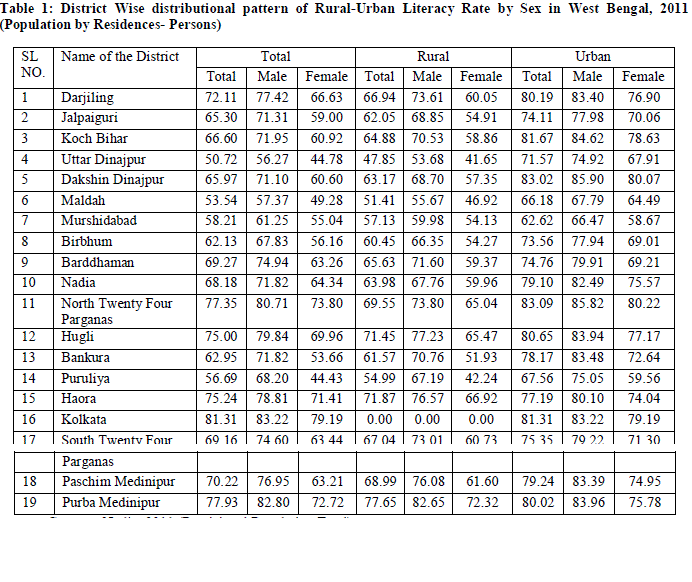 |
 |
| The highest Non- SC literacy rate [Non- SC Literacy Rate = (Total literate population – Total SC literate population)/ (Total population - Total SC population)*100] is appeared in the district of Kolkata 82.83 percent followed by Hugli 79.56 percent, Purba Mednipur 78.97 percent and North Twenty Four Parganas 78.86 percent and the lowest literacy rate of Non-SC is found in Uttar Dinajpur 49.56 percent followed by Malda 53.64 percent and Purulia 58.71 percent. On the other hand highest SC literacy is recorded in North Twenty Four Parganas 77.84 percent followed by Kolkata 72.25 percent and Purba Mednipur 71.83 percent and lowest in the district of West Bengal is Bankura 46.79 percent followed by Purulia 47.76 percent and Birbhum 51.37 percent. The highest literacy rate of SC population is found in thus areas which mainly urban dominated areas because educational and employment migration is found more in urban areas as compared to rural state. People of the Schedule Caste living in the urban areas are more conscious for their future generation, mainly due to financial position. Schedule Caste populations which are living in urban areas comparatively more developed to rural Schedule Caste population. |
| Figure 1 is a comparative bar diagram which give comparative analysis about the literacy differences among the Non SC and SC population. This difference is calculated from the literacy rate SC subtracted from literacy rate of Non- SC population. The wide differences is found in the district of Bankura which is 24.19 percent followed by Barddhaman district 19.46 percent, Birbhum 15.26 percent and Haora 14.15 percent and The lowest differences is recorded in Maldah which is only 0.92 percent. The reason is that district of Maldah mainly dominated by the Muslim population. Literacy rate of Muslims population is also lower as to Schedule Caste population. |
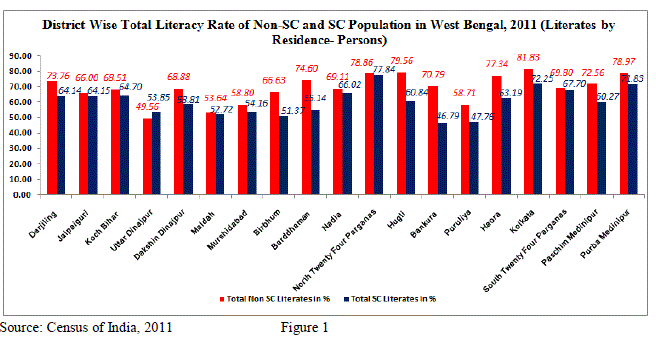 |
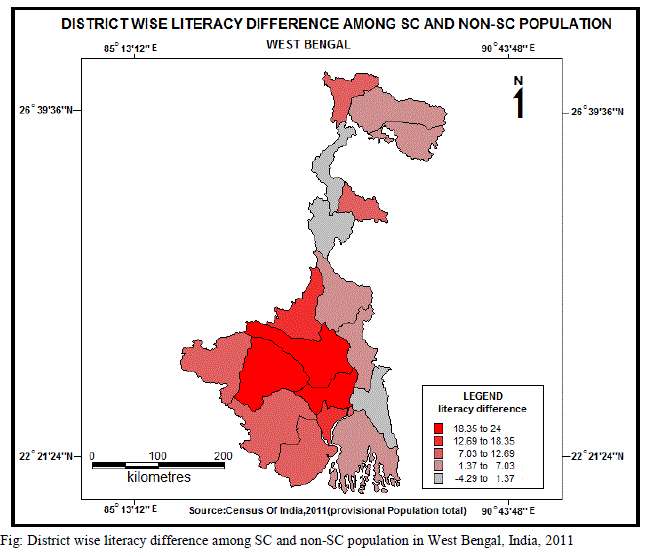 |
VI. MALE AND FEMALE LITERACY DIFFERENCE AMONG THE NON- SC AND SC POPULATION IN WEST BENGAL |
| Figure 2 shows the distribution of male literacy rate of Non- SC and SC population of the state on the basis of 2011 census data. The highest male literacy of Non- SC is appeared in Hugli 83.68 percent followed by Purba Mednipur 83.64 percent and Kolkata 83.54 percent and lowest in Uttar Dinajpur 54.43 percent followed by Maldah 56.85 percent and Murshidabad 61.48 percent. On the other hand the highest literacy of SC population is found in Purba Mednipur 77.87 percent followed by Kolkata 77.66 percent and North Twenty Four Parganas 77.01 percent and lowest in the district of Bankura which is 56.85 percent followed by Birbhum 58.82 percent and Maldah 59.32 percent. This figure also shows the difference between male literacy rate among the Non- SC and SC population in West Bengal. This difference is calculated, male literacy of SC is subtracted from male literacy of Non- SC. The highest differences are found in Bankura 22.09 percent followed by Brddhaman 16.59 percent Hugli 12.78 percent. The lowest difference is in South Twenty Four Parganas 0.41 percent followed by Nadia district 0.92 percent and Jalpaiguri 1.50 percent. The district of Uttar Dinajpur and Maldah is only two districts where the literacy rate of Schedule Castes is found higher than the literacy rate of Non- Schedule Castes population. Main reason is that mostly populations in Uttar Dinajpur compared are of Muslims and Schedule Tribes (ST) so the literacy rate of Muslims and Schedule Castes population is also lower to Schedule Castes population. |
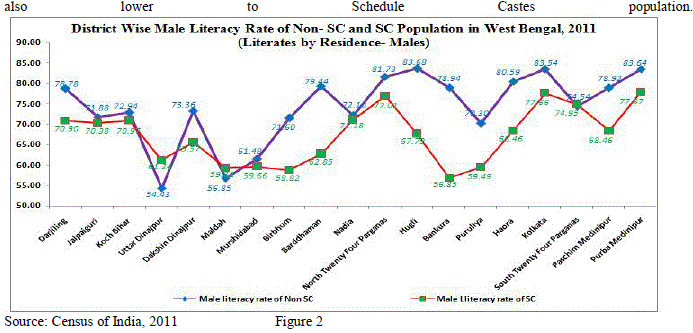 |
| Figure 3 shows the district wise female literacy rate of Non- SC and SC population of the state of West Bengal. The highest female literacy of Non- SC is recorded in Kolkata 79.93 percent followed by North Twenty Four Parganas 75.83 percent and Hugli 75.25 percent. The lowest female literacy of Non- SC is found in Uttar Dinajpur 44.37 percent followed by Puruliya 46.59 percent and Maldah 50.24 percent. In other hand, the highest female literacy of SC population is appeaered in North Twenty Four Parganas 66.36 percent followed by Kolkata 66.17 percent and Nodia 60.52 percent. The lowest percentage of female literacy rate is found in the district of Puruliya 35.45 percent followed by Bankura 35.50 percent and Birbhum 43.55 percent. |
| This Line graph also presents the difference of the district wise female literacy rate of Non- SC and SC population. The highest differences is recorded in Bankura district which is 25.65 percent followed by the district of Barddhaman 22.32 percent and Hugli 21.56 percent and the lowest difference is in Dakhin Dinajpur 1.55 percent. |
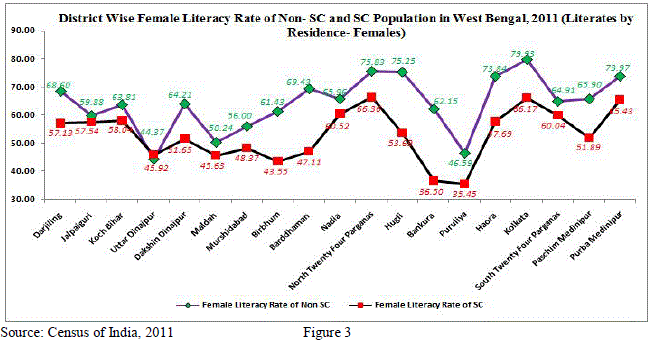 |
| Figure 4 shows that the situation of literacy by distribution of Non- SC and SC in Rural areas of the state according to 2011 census data. The highest level of literacy of Non- SC is recorded in Purba Mednipur 78.72 percent followed by Hugli 77.39 percent and Kolkata 75.35 percent and lowest in Uttar Dinajpur 45.86 percent followed by Maldah 51.30 percent and Puruliya 56.86 percent. The highest rural literacy of SC is existed in Purba Mednipur 71.60 percent followed by North Twenty Four Parganas 68.84 percent and South Twenty Four Parganas 66.50 percent. The lowest rural literacy of SC population is found in Bankura 46.09 percent followed by Puruliya 47.10 percent and Birbhum 50.54 percent. |
VII. RURAL URBAN LITERACY DIFFERENCES AMONG THE NON- SC AND SC POPULATION IN WEST BENGAL |
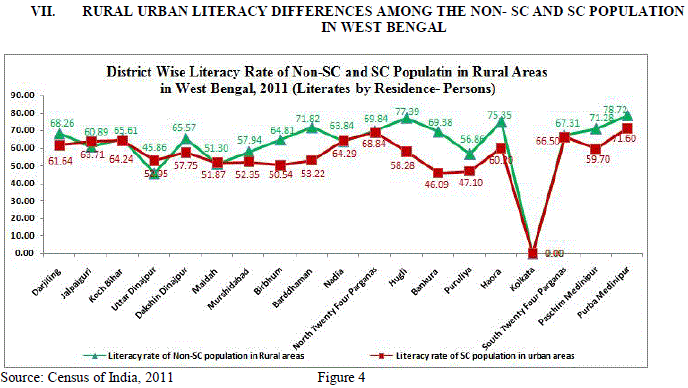 |
| Figure 5 shows that the district wise literacy rate of Non- SC and SC population in urban areas of West Bengal. The highest urban literacy of Non- SC is recorded in Dakhin Dinajpur 85.14 percent followed by Nadia 84.43 percent and Bankura 80.16 percent. The lowest urban literacy of Non- SC is found in Murshidabad 62.72 percent followed by Maldah 66.58 percent and Uttar Dinajpur 73.31 percent. In other hand, the highest urban literacy of SC population is appeared in North Twenty Four Parganas 75.94 percent followed by Koch Bihar 74.29 percent and Purba Mednipur 74.16 percent. The lowest percentage of urban literacy rate of SC is found in the district of Puruliya 51.97 percent followed by Bankura 58.01 percent and Birbhum 59.18 percent. |
VIII. CONCLUSION AND REMEDIES |
| From the above discussion it can be concluded that literacy rate of Schedule Caste is extremely low than the Non- Schedule Caste population of state of West Bengal. Literacy differences between SC and Non- SC population of West Bengal have wide gender gap in literacy rate among the Schedule Caste. The main reasons behind low literacy among the Schedule Caste population are their Employment, Socio- economic and political backwardness. Government takes some step to improve the education, quality of life and socio-economic backwardness of SC population and implicates some policies such as- Government provide mid day meal, free uniform, free books and cycles to Schedule caste of West Bengal at school level. Many scholarships are given to SC student by State Government and central Government and different training program also lunch by State and Central Government which improve literacy and employment structure of the Schedule Caste. But only this policies are not sufficient because education of the girls in rural areas of the state is very poor so, Government should aware the people of Schedule Caste who are living in rural areas specially woman literacy. In the state of West Bengal some areas are more backward like Puruliya, Birbhum, Barddhaman, and Bankura in the term of literacy; Government should give more attention low literacy areas of the states. |
References |
|